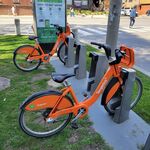EVENT: Connecting The Dots of transit wayfinding in the GTHA
http://spacing.ca/toronto/2015/03/11/event-connecting-dots-transit-wayfinding-gtha/
MISSISSAUGA EVENT
WHAT: Connecting The Dots: Mississauga event
WHEN: Tuesday, March 24, 7-9pm
WHERE: Sheridan College, Hazel McCallion campus, 4180 Duke of York Blvd., Mississauga
COST: Free!
TICKETS: Reserve your MISSISSAUGA tickets at Eventbrite
(please note that there will be tickets available at the door)
TORONTO EVENT
WHAT: Connecting The Dots: Toronto event
WHEN: Wednesday, March 25, 6:30-9pm
WHERE: Isabel Bader Theatre, 93 Charles St. W., Toronto
COST: Free!
TICKETS: Reserve your TORONTO tickets at Eventbrite
(please note that there will be tickets available at the door)
ABOUT THE EVENT
“Am I at the right stop?” “Which direction am I going?” “Which exit do I want?”
At its best, transit wayfinding — the maps, signs, graphics and other information that help transit users navigate — can simplify complex networks and encourage transit use by helping to answer the questions transit users ask throughout their journeys. At its worst, poor wayfinding can make using transit a confusing and stressful experience.
Please join us for an evening — in either Mississauga or Toronto — to learn more about transit wayfinding, with a lecture by Tim Fendley, founder and owner of UK-based Applied Wayfinding, who designed Vancouver’s new transit wayfinding system and the award-winning “Legible London” pedestrian wayfinding system; and by Helen Kerr of Toronto-based KerrSmith Design whose citizen-centered innovation projects include “Economic Futures for Ontario” and “Re-Imagining Detroit.” Tim Fendley and Helen Kerr are working together on the Transit Wayfinding Harmonization initiative being undertaken jointly by the ten transit agencies of the Greater Toronto and Hamilton Area (GTHA) to seamlessly connect existing transit systems into a legible network. They’ll discuss the harmonization opportunity that exists for the GTHA, challenges presented by the complexity of this region, and insights from initial design research that is being used to develop a user-centred vision for regional transit wayfinding.
In order to bring you this event, Spacing has partnered with Metrolinx, Ryerson University’s City Builders Institute, Sheridan College, and Daniels Faculty of Architecture, Landscape, and Design, and Urban Strategies
---------------
If I was in Toronto, I'd be there. I think this is going to give a real vision into the future look and feel of transit in the GTHA.




